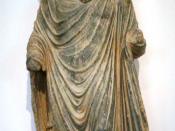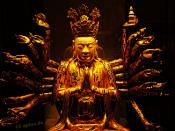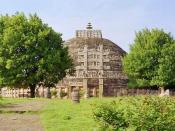The earliest civilization of south Asia was located in the Indus Valley. The civilization was progressing and had advanced concepts and techniques. The culture suddenly vanished with little explanation. Some believe that there was an abrupt climatic change or attacks from surrounding areas. Since so little is known about the Indus Valley inhabitants, their artwork is an insight to their way of life.
One of the most extraordinary portrayals of a human form is that of the Torso. It is a nude torso of man, depicted with naturalistic style. In contrast to the more athletic male ideal developed in Ancient Greece and the Near East, this sculpture emphasizes the soft texture of the human body and the differences of the muscular form. The abdomen is relaxed in the manner of a yogi able to control his breath. This depicts the way of life for these people. They may have practiced religious exercises such as meditation.
Meditation was one aspect of Buddhism which came about in this time period.
Another piece that gives insight to the values of this society is the Yakshi Holding a Fly Wisk. The art created in this time period reflected heroes and the increasing practice of Buddhism. The idea of dharma emerged and is depicted in this statue. The woman has large breasts and hips which embody the ideal of a fertility, bounty, and auspiciousness(marked by lucky signs or good omens, and therefore by the promise of success or happiness). These characteristics reflect the gods and the working of dharma in the world. The statue is sculpted from the fine-grained sandstone. Her vertical posture represents strength and dominance of her kind, and she is a powerful figure of her time. Wearing ornaments and jewelry on her body may represent her wealth and importance to appear...


